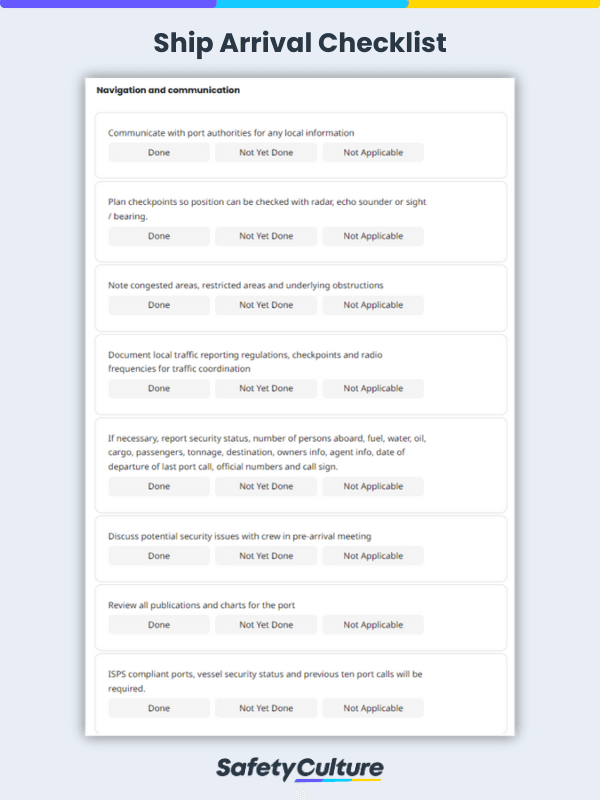What are Vessel Arrival and Departure Checklists?
Also called pre-arrival and pre-departure checklists, these are tools used by mariners before, during, and after arrival or departure at ports. They help mariners, especially those in the bridge and engineering team, ensure that a ship is ready to dock at ports or is seaworthy before departure for the next destination.
Vessel arrival and departure checklists serve as a guide for seafarers to guarantee that all necessary and crucial steps are taken to help promote safety and comply with international regulations and standards.
Why are Arrival and Departure Checklists Important?
How does having a pre-departure and pre-arrival checklist help you? Vessel arrival and departure are time-sensitive and depending on current circumstances at sea and shipyard port, can be challenging and dangerous. Through checklists, seafarers can prepare for arrival and departure of ships more efficiently as well as promote the following:
• Security and safety of the crew and passengers
Arrival and departure checklists help the crew go through all the essential steps to ensure the safety of the ship’s arrival and departure—both for the people on board as well as those at the seaport.
• Damage prevention
The checklists contain steps on what to check first to make sure that the ship, its cargo, and the port are safe for docking and departure.
• Timely departure and arrival
Using a checklist can help with efficiency, thus saving time, and help the ship stay on schedule. Inefficiency and delays can result to costly recurring penalties and damage business reputation.
What are the Main Points to Review in Pre-Arrival and Pre-Departure Checklists?
Pre-arrival and pre-departure checklists aim to cover all essentials beforehand, in compliance with international and local regulations and standards. Here are some of the main points covered by arrival and departure checklists:
Arrival
- Navigation and communication
- Inform the receiving seaport at least 3 days before the planned arrival
- Provide all ship information required by the port authorities
- Meet the crew and inform them of any potential security concerns
- Check lights and test inter-ship communication
- Be aware of any obstruction to the ship’s arrival
- Ensure that the flag hoisted is appropriate
- Anticipate any wind change
- Documentation
- Prepare all documentation needed for the port call, ensuring that they have the ship’s official stamp and signature of the Master
- Steering and propulsion
- Test the steering gear (per SOLAS Regulation)
- Safety
- Check the perimeter of the ship and secure mooring lines, cables, and straps
- Ensure that the main engine gear boxes are in good working condition
- Secure any loose objects on the bridge
- Crew
- Brief the crew on duties during mooring
- Remind crew of protocol regarding suspicious activity
- Pilot
- Be ready for the pilot’s arrival and boarding
- Be briefed on any security issues, regulations, etc, at the port
- Secured along side
- Inform engineering when ready to secure engines
- Put radar on standby
- Monitor communications with port authorities using radios
Departure
- Navigation and communication
- Ensure crew members are oriented on vessel duties (per SOLAS Regulation)
- Check that voyage plan has an updated crew list
- Ensure that authorities have provided permission to depart
- Check lights and test inter-ship communication
- Test radars and other essential equipment to ensure good working condition
- Ensure that the flag hoisted is appropriate for the destination
- Documentation
- Record the vessel’s draft in the logbook (per 46 CFR 131.510)
- Ensure that log compasses are on and gyro settings are correct
- Check and log if the Global Maritime Distress and Safety System (GMDSS) is in good working condition
- Check all marine crew certificates and log if all are qualified and affix the signature of the Master
- Steering and propulsion
- Test the steering gear (per SOLAS Regulation) and once engines are running, check that gauges are in working order
- Safety
- Ensure that flashlights and emergency lights are working properly
- Check life rafts, rings, strobes, and smoke buoys
- Secure any loose objects on the bridge
- Before cast-off
- Ensure that those aboard are intended to be there before departure. Check for stowaways
- All watertight doors and hatches should be secured
- Loose gear on all decks should be secured
- Clear all obstructions or floating debris around the vessel
- Ensure proper PPE for all at mooring lines
- Inform engine room before cast-off
- After cast-off
- Activate radars that are in standby mode
- Ensure that mooring lines are properly stowed
- In open water
- Secure anchor windlass
- Update port authorities of ship status
Vessel Arrival and Departure Checklist FAQs
The master of the ship is responsible for preparing the entire vessel for arrival and departure. They will relay orders to all crew members for getting ready to depart and arrive. Before leaving the dock, they must follow and document procedures to ensure compliance with seafaring regulations.
A vessel pre-departure checklist is essential to ensure you have all the items needed before the trip. It should contain the following items:
- General preparations
- Weather forecast
- Condition of the boat
- Tools and equipment
- Navigation aids and lights
- Emergency signals
- Documentation
A pre-departure checklist is crucial to navigating the coastal waters safely. This checklist helps marine officers get their ships ready for sailing before departing and arriving on the dock. It also makes sure that crew members can thoroughly run through every aspect of the ship’s engineering and operations without missing any item.


